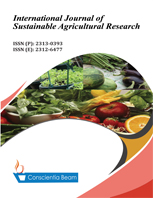Partial Budgeting Analysis of Different Strategies for Management of Insect Pests in Cashew and Mango Orchards in Tanzania
DOI:
https://doi.org/10.18488/journal.70/2015.2.4/70.4.98.110Abstract
Before changing from one production method to another, farmers need to consider costs and incomes resulting from the change. This study estimated the effects on net benefit of switching from conventional Tanzanian growing practices (spraying of chemical pesticides and non-pest control) to the use of African weaver ants (Oecophylla longinoda) to control pests in cashew and mango. Yield data from one cashew and one mango plantation covering two cropping seasons was used in an economic analysis. The use of chemical pesticides and the use of weaver ants resulted in higher yields compared to the non-control treatment. Lower input costs in weaver ant treatments, though, resulted in higher economic returns than the use of chemical insecticides in both seasons and crops. In all cases weaver ant treatments also produced higher returns than non-control treatments, despite their higher costs. Switching to African weaver ants without feeding was feasible due to positive net change in benefits in both crops. In cashew the average net benefit for the two seasons was 94% higher when using ants compared to non-control and 112% higher than in the chemical treatment. The corresponding values in mango were 117% and 63%, respectively. Marginal Rate of Return (MRR) was highest for African weaver ants without feeding in cashew at 235% in 2012/13 and 405% in 2013/14 seasons. Similarly, MRR was highest for weaver ant without feeding in mango at 509% in 2012/13 and 743% in 2013/14 seasons. In conclusion, the use of African weaver ants without feeding was consistently the most economically feasible management strategy to be used in Tanzanian cashew and mango pest management.

